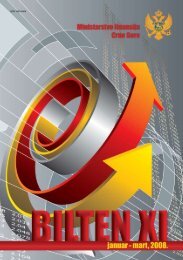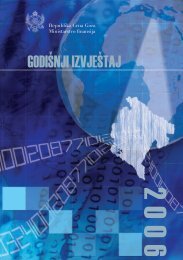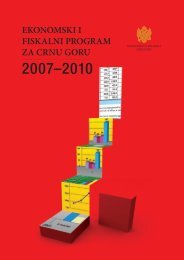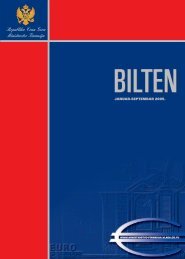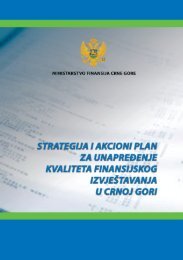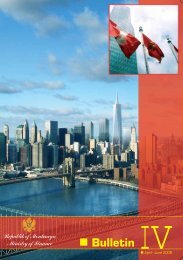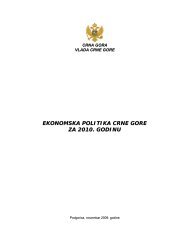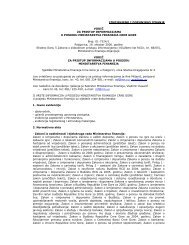Republic of Montenegro: Public Expenditure and ... - Vlada Crne Gore
Republic of Montenegro: Public Expenditure and ... - Vlada Crne Gore
Republic of Montenegro: Public Expenditure and ... - Vlada Crne Gore
You also want an ePaper? Increase the reach of your titles
YUMPU automatically turns print PDFs into web optimized ePapers that Google loves.
60 Chapter 4: <strong>Public</strong> Financial Management <strong>and</strong> Procurement<br />
amount (EUR 439 versus 449), <strong>and</strong> a similarly high level is expected for 2005. Despite<br />
variations that occur across economic classifications <strong>and</strong> across ministries, the annual budget<br />
appears to be a credible representation <strong>of</strong> government’s spending priorities for the year. Apart<br />
from the decision in 2004 to repay credits to financial institutions, there was no major overspending<br />
either by economic classification or by ministry.<br />
4.14 Notwithst<strong>and</strong>ing the aggregate stability, some significant shifts in the composition <strong>of</strong><br />
expenditures sometimes occur that could undermine the quality <strong>of</strong> public expenditure in<br />
the future. Two categories <strong>of</strong> expenditure that suffered in 2004 were “cost <strong>of</strong> recurrent<br />
maintenance” <strong>and</strong> “investment maintenance <strong>of</strong> infrastructure.” While it is not uncommon among<br />
governments to reduce maintenance spending when there is a cash shortfall, a pattern <strong>of</strong><br />
consistent under-spending on maintenance <strong>of</strong> assets could generate large future liabilities.<br />
Problems may also arise due to unanticipated reductions in allocations to specific ministries.<br />
The Ministry <strong>of</strong> Health <strong>and</strong> the Ministry <strong>of</strong> Maritime <strong>and</strong> Transport stood out in 2004 as those<br />
with the lowest rates <strong>of</strong> budget execution (36 percent <strong>and</strong> 46 percent respectively). Apart from<br />
the negative effect on operations, such large shifts may increase skepticism about the credibility<br />
<strong>of</strong> budget allocations <strong>and</strong> may encourage exaggerated estimates from line ministries <strong>and</strong> may<br />
contribute to accumulation <strong>of</strong> arrears.<br />
Program Budgeting<br />
4.15 Program budgeting is still in its infancy. Though program budgeting has been the most<br />
prominent <strong>of</strong> reforms introduced by MoF in the last few years, it has yet to result in any<br />
pr<strong>of</strong>ound changes in the budget planning process within government. Since 2004, when the first<br />
two ministries piloted program budgets, more have been added each year. By 2006 most <strong>of</strong> the<br />
major ministries had been included in the piloting <strong>of</strong> program budgets, <strong>and</strong> many <strong>of</strong> the others<br />
will be added in 2007. The gradual roll-out has in part reflected capacity concerns within MOF.<br />
But even as the number <strong>of</strong> ministries has increased, neither the quality <strong>of</strong> the output nor the<br />
impact on the process has changed much.<br />
4.16 In reviewing the program budgets for 2006, several weaknesses st<strong>and</strong> out in how<br />
pilot ministries have undertaken the process, starting with the structure <strong>of</strong> programs. For<br />
example, ministries have defined their programs in a way that appears to reflect their past<br />
administrative or organizational structure rather than any strategic regrouping <strong>of</strong> missions <strong>and</strong><br />
primary objectives. The programs are defined inconsistently even within the same ministry.<br />
They are sometimes highly fragmented <strong>and</strong> do not reflect a prioritization <strong>of</strong> key missions. For<br />
example, in the Ministry <strong>of</strong> Education <strong>and</strong> Science there are a few large programs that consume<br />
most <strong>of</strong> the resources, but there are also several very narrow activities that are each defined as<br />
programs <strong>and</strong> use very little budget. At the very least, it presents the ministry as fragmented<br />
activities without a coherent or unifying theme.<br />
4.17 The lack <strong>of</strong> underst<strong>and</strong>ing about how to define programs also st<strong>and</strong>s out in the case<br />
<strong>of</strong> the Ministry <strong>of</strong> Interior. Though they are supposed to have a program budget, in fact, the<br />
budget reflects little more than a single program. Policing involves a few different functions, but<br />
it is defined by the Ministry as a single program that consumes about 85 percent <strong>of</strong> the budget.<br />
There are only two other programs defined by the Ministry, one <strong>of</strong> which uses only about 1





